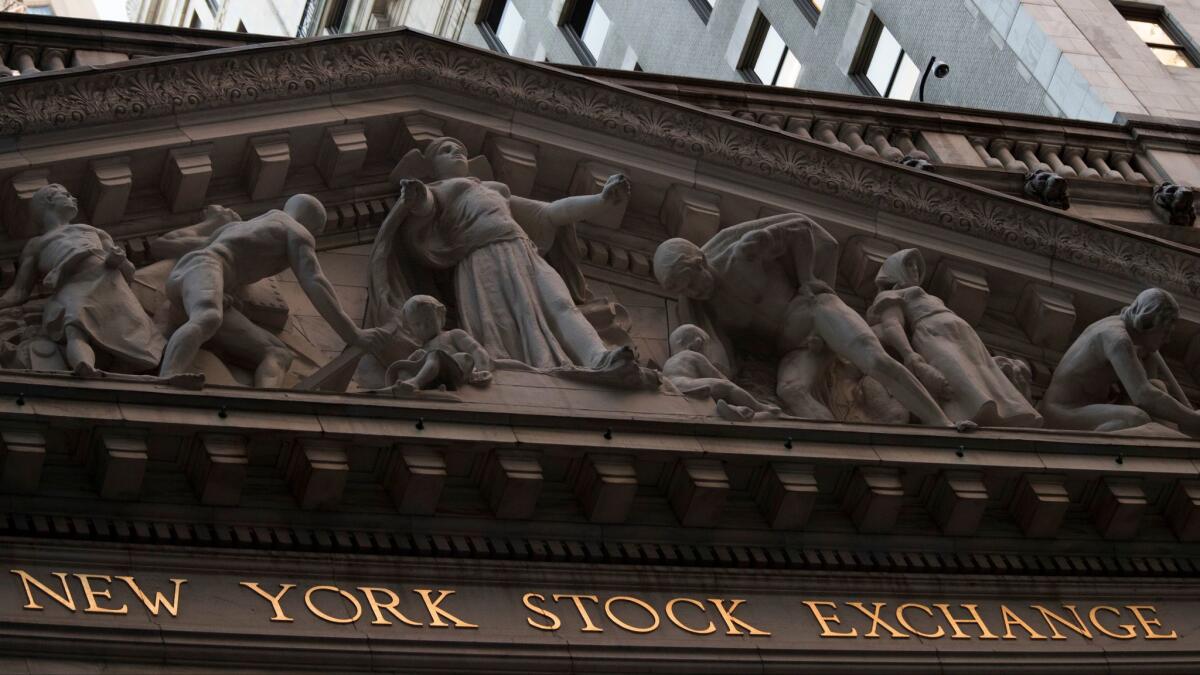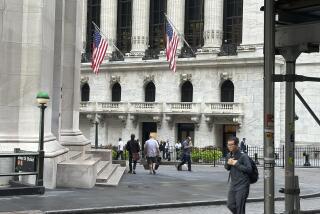Column: Have stocks reached ‘a permanently high plateau’? Or: Whatever happened to market corrections?

- Share via
You may not have noticed it, but the stock market suffered a correction about two weeks ago.
Sort of a correction, anyway: These market events are defined as downturns of roughly 10% from recent highs. The downturn on May 17, which took the Dow Jones industrial average down by 372.82 points, amounted to only 1.8%.
Nonetheless, financial pundits viewed the action as heralding a sea change in market psychology, tied to new evidence of the Trump administration’s inability to get tax cuts done. Yet the very next day, the Dow gained back more than 56 points, and as of Tuesday’s trading close, the average still was almost 50 points higher than it was before the big drop on May 17 (despite a fall of about 51 points from Friday’s pre-holiday close).
Boomers are going to live longer.... You can’t fund a 30-year retirement with bonds or cash.
— Josh Brown, explaining why the market seems resistant to corrections
The truth is that corrections, which used to occur about once a year and last for a few months, lately have become shorter and less frequent; the last one lasted from the beginning of December 2015 to early February 2016, when the Dow shed about 12.5%.
As often happens, this trend has people speculating about whether a permanent change in the stock market has made corrections (as we used to experience them) relics of the past.
The dangers of over-optimism are well-documented, not least by the story of Yale professor Irving Fisher, who permanently destroyed a reputation as the nation’s leading economist by declaring on Oct. 16, 1929, that stocks had reached “what looks like a permanently high plateau.” The stock market crash struck 13 days later.
So are the dangers of pessimism — witness one of the most famous negative prognostications of all time, the August 13, 1979, cover of BusinessWeek proclaiming “The Death of Equities.” The Dow was mired in the 800s at the time; it’s now above 21,000. Investment markets of all types tend to encourage followers to believe that the future will be just like the present, except more so.
Still, there have been some changes in the market in recent years that may account for what even pessimistic analysts consider its remarkable resiliency. To understand them, we called on one of the most sober-minded investment experts we know, Joshua Brown of Ritholtz Wealth Management and the Reformed Broker website. Brown spotted some of these changes back in 2014. The blog post he wrote then about the “relentless bid” has remained so true it could have been written now. (In fact, at first I mistook it for a new post.)
The key to Brown’s explanation was a shift at major brokerages away from commission trading to fee-based asset management. Today more than one-third of accounts at some wire houses is fee-based — at Morgan Stanley, for example, the percentage rose to 42% in 2016 from 37% in 2013. Nationwide, assets in fee-based accounts can be estimated at nearly $3 trillion, up from less than $200 billion in 2005.
“The old investment business model was to get clients to trade all the time” to generate commission income, Brown told me. Today’s model is to collect a fee based on assets under management. The change doesn’t entirely eliminate conflicts of interest between broker and client, but it does eliminate the incentive to churn the client’s account.
The change in brokerage habits coincided with a shift toward passive rather than active mutual funds. The high-water mark of actively managed funds may have been reached in the 1980s, when Peter Lynch managed Fidelity’s Magellan Fund from $18 million to $14 billion in assets during his reign from 1977 to 1990.
Investors soon recognized that trying to beat the market averages consistently via active trading was a mug’s game. They moved to index funds, which merely try to replicate the broad market indices and do minimal trading. Vanguard’s Standard & Poor’s 500 index fund supplanted Magellan as the world’s largest mutual fund in 2000. Vanguard’s portfolio of passive funds have more than doubled their assets to $4.2 trillion in the last three years, a period in which the inflows to its funds has outstripped those to all other U.S. mutual fund companies combined more eight times over.
As a result of these developments, investors and their managers became “increasingly agnostic about the news of the day,” Brown observed in 2014. Instead, they view every dip in the market as a buying opportunity. “The market always looks better if you can buy at a discount,” he told me.
Adding to the trend is a changing perception of market demographics. It wasn’t very long ago that prognosticators expected a downturn in stocks, or at least flattening growth, because of the baby-boomer retirement wave. The theory was that boomers who had spent their productive years investing for retirement would now be liquidating their stock holdings either to live on or to protect their next eggs by shifting into bonds.
That hasn’t happened, in part because the nature of retirement has changed. “Boomers are going to live longer,” Brown says; actuarial tables show that an American who reaches age 65 can expect on average to live another 20 years, and many to age 95. “What does someone living longer need — current income or future growth?” he asks. “You can’t fund a 30-year retirement with bonds or cash.”
Brown cautions that none of this means that the stock market has become immune from a major decline. “My theory does not mean ‘It’s different this time,’” he wrote in 2014. “I am describing what has been going on as relentless, not endless. I am also not projecting it out indefinitely into the future.”
Indeed, as anyone who follows the investment world knows (and Professor Fisher forgot, to his eternal shame), markets have a way of confounding all expectations, sometimes within days.
After all, stocks already have staggered through two major bear markets in this young century — in 2000 and 2008. Brown expects that this bull market, too, will end because of a downturn in the economy (the technology crash of 2000 and the housing crash and recession in 2008). Another such hit could well sour the small investor on equities generally. So, too, could a sustained rise in interest rates, which would make fixed-income investments relatively more attractive than stocks while driving down corporate profits.
But Brown knows the “relentless bid” theory is alluring to people looking for “a narrative to answer to why market pullbacks that used to take months now only take days or weeks.” If the thousands of posts he’s written over the years, he says, “this seems to be the one that people keep coming back to. I get emails about it all the time.”
Keep up to date with Michael Hiltzik. Follow @hiltzikm on Twitter, see his Facebook page, or email [email protected].
Return to Michael Hiltzik’s blog.
More to Read
Inside the business of entertainment
The Wide Shot brings you news, analysis and insights on everything from streaming wars to production — and what it all means for the future.
You may occasionally receive promotional content from the Los Angeles Times.











